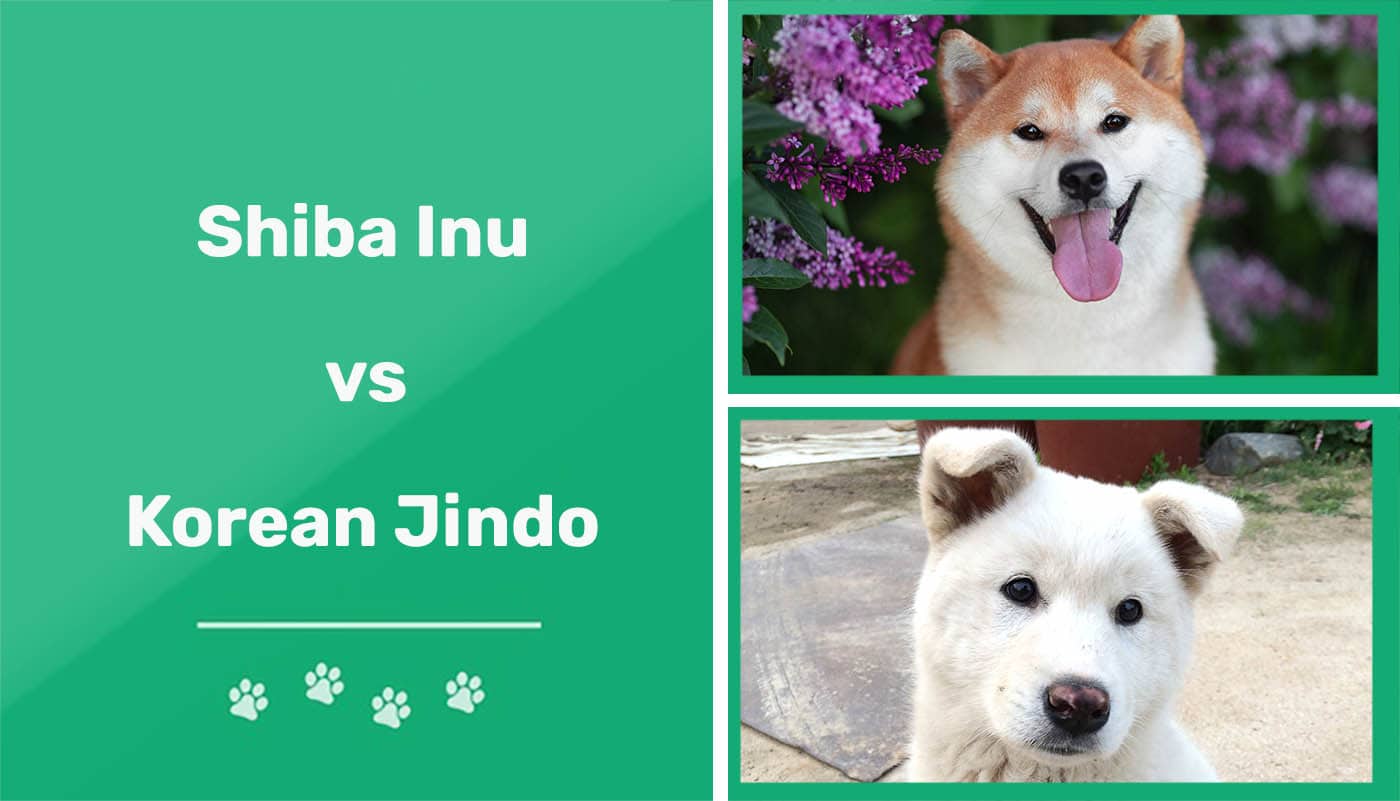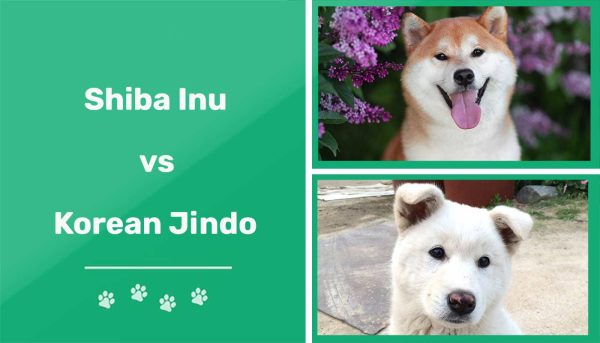Click to Skip Ahead
Both Shiba Inus and Korean Jindos have captured the hearts of many with their loyal and spirited nature, but they differ in various aspects, from physical appearance to temperament. In this quick guide, we will delve into the distinctive traits that make these two breeds stand out in the canine world. Shiba Inus, known for their spirited nature and charming fox-like appearance, have captivated dog lovers worldwide. On the other hand, Korean Jindos, with their regal and independent nature, have a rich history deeply rooted in their homeland. By exploring their temperament, size, grooming needs, and trainability, we will uncover the key differences and similarities between these fascinating breeds.

Visual Differences

At a Glance
- Average height (adult): 14–16 inches
- Average weight (adult): 17–23 pounds
- Lifespan: 12–15 years
- Exercise: 1+ hours a day
- Grooming needs: Mildly moderate
- Family-friendly: Yes
- Other pet-friendly: Yes
- Trainability: Can be difficult, should be started early
- Average height (adult): 21–26 inches
- Average weight (adult): 55–80 pounds
- Lifespan: 10–13 years
- Exercise: 2+ hours a day
- Grooming needs: Moderate
- Family-friendly: Yes
- Other pet-friendly: Often
- Trainability: Intelligent but stubborn
Shiba Inu Overview
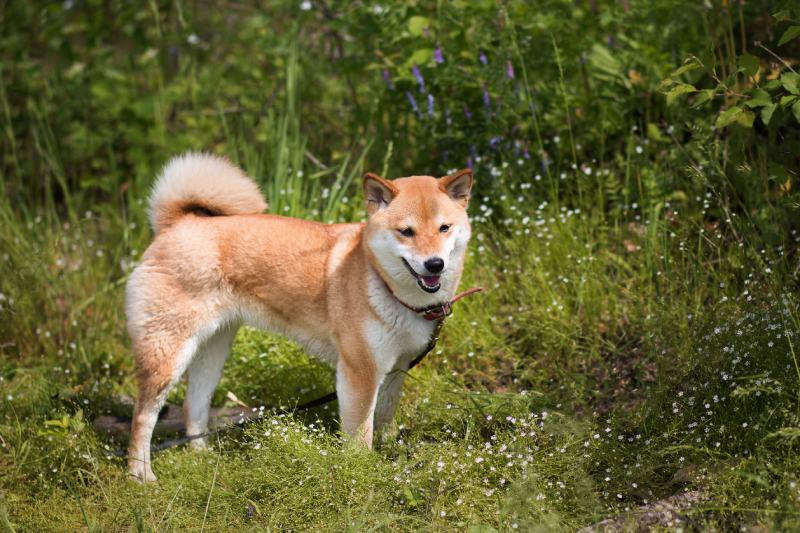
History
The Shiba Inu originated in Japan and has a pretty interesting history. It’s believed to be one of the oldest and smallest native breeds in Japan, with its origins dating back thousands of years. The exact origin of the Shiba Inu is still debated among experts, but it’s thought to have descended from ancient Japanese hunting dogs. These dogs were used for hunting small game, such as rabbits, birds, and ducks, in the mountainous regions of Japan. The Shiba Inu’s small size and agile nature made it well-suited for this type of hunting.
The Shiba Inu breed almost faced extinction during World War II due to bombings and the resulting food shortages in Japan. After the war, only a few surviving individuals were used to rebuild the breed’s population. In the following years, the Shiba Inu gained popularity both in Japan and internationally. It was recognized by the Japan Kennel Club in 1920 and later by the American Kennel Club in 1992.
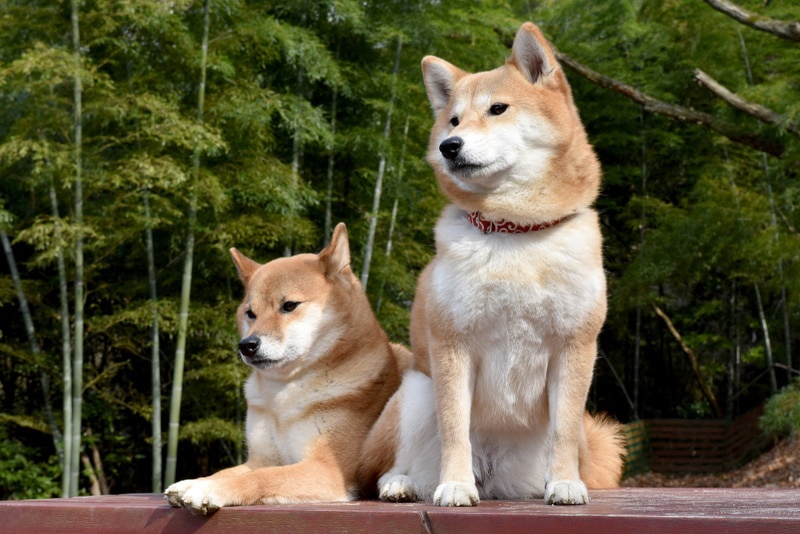
Personality
The Shiba Inu is a breed that’s known for its unique and independent temperament. They’re often described as cat-like dogs due to their aloofness and self-reliance. Unlike some other dog breeds, Shibas aren’t known to be overly affectionate or clingy. They prefer to have their own space and can be quite reserved when it comes to strangers. This independent nature can sometimes make them appear aloof or stubborn, but it’s important to remember that it’s simply a part of the breed’s character.
One of the defining traits of the Shiba Inu is their strong-willed nature. They’re intelligent and have a mind of their own, which can sometimes make training a challenge. Shibas are known for their independent thinking, and they may not always obey commands blindly. This doesn’t mean that they’re disobedient or difficult to train; it simply means that they require a patient and consistent approach to training.
In addition to their strong-willed nature, Shibas are also known for their mischievous tendencies. They have a playful and curious nature, which can sometimes lead them to get into trouble. Shibas are also expert escape artists, believe it or not, and can be quite creative when it comes to finding ways to explore their surroundings. It’s important to provide them with mental and physical stimulation to keep their mischievous side in check.
Despite their independent attitudes, Shiba Inus are also incredibly loyal to their human companions. Once they form a bond with their owners, they’re super devoted and protective.

Training
Training a Shiba Inu can be quite challenging due to their strong-willed and independent nature. These lovable yet stubborn dogs have a reputation for being difficult to train, even for experienced dog owners. One of the main reasons why Shiba Inus can be hard to train is their innate sense of independence. They are known for their strong personality and often have a mind of their own. This can make it challenging to get them to follow commands or engage in obedience training.
Also, Shiba Inus are highly intelligent dogs, which can actually work against them in training. They tend to quickly pick up on patterns and routines, which means they may become bored or lose interest in training sessions if they feel that the tasks are repetitive or unchallenging.
Therefore, it’s essential for owners to create engaging and stimulating training sessions that keep their Shiba Inus mentally stimulated and motivated. Patience, consistency, and positive reinforcement are key when it comes to training a Shiba Inu. It may take more time and effort compared to other dog breeds, but with the right approach and a lot of persistence, Shiba Inus can, in fact, be trained successfully.
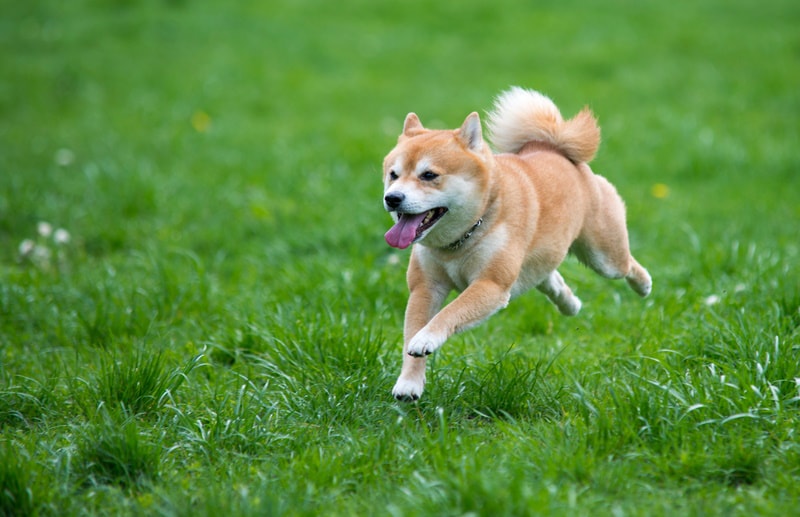
Health
Shiba Inus, a popular breed of dog known for their spirited and energetic nature, are unfortunately prone to several health conditions.
Another health issue that Shiba Inus are susceptible to is patellar luxation. It occurs when the kneecap becomes dislocated from its normal position, causing pain and difficulty in walking. Shiba Inus with patellar luxation may exhibit symptoms such as limping, lameness, or an abnormal gait. Surgical intervention may be necessary to correct severe cases of patellar luxation, while milder cases can often be managed with pain medication and physical therapy.
Atopy is another common condition seen in Shiba Inus. Also known as allergic dermatitis, atopy is an allergic reaction to environmental allergens such as pollen, dust mites, or certain foods. Shiba Inus with atopy may experience itching, redness, and skin infections. Treatment for atopy often involves identifying and avoiding the allergen triggers, as well as using medications such as antihistamines or steroids to alleviate symptoms.
Suitable For:
Shiba Inus are a unique breed that requires a specific type of owner. They are best suited for individuals or families who have experience with dog ownership and are willing to put in the time and effort to properly train and socialize them.
Korean Jindo Overview
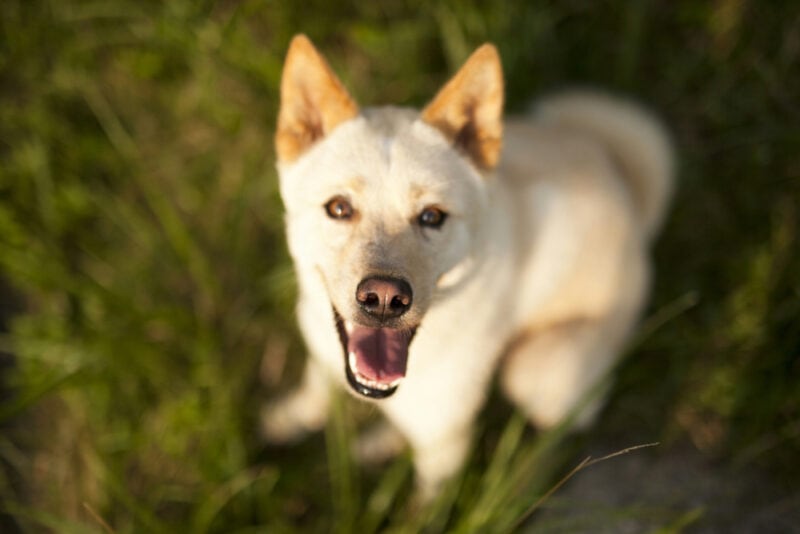
History
Originating from Jindo Island in South Korea, these dogs were originally bred for hunting game, including boar and deer. The name “Jindo” actually comes from the island itself, where the breed was developed. Jindos are known for their loyalty, intelligence, and strong hunting instincts.
The history of the Korean Jindo dog breed is closely tied to the people of Jindo Island. These dogs were highly valued by the islanders for their hunting skills and ability to protect their livestock. They were also used for guarding homes and acting as companions to their owners. The Jindos were considered a symbol of good fortune and were often given as gifts to important figures in Korean society.
In the 1930s, efforts were made to preserve the breed and establish it as a recognized breed in South Korea. In 1962, the Korean government officially recognized the Jindo as a national treasure and took measures to protect and preserve the breed’s purity. Today, the Jindo is highly regarded both in its home country and around the world.

Personality
Korean Jindos are highly intelligent and have a strong sense of loyalty towards their owners. However, they can also be quite stubborn and can display dominant behavior if not properly trained and socialized from an early age. Despite their independent nature, Jindos are also very affectionate towards their family members and are known to be protective of their loved ones. With the right training and socialization, the Korean Jindo can make a wonderful companion for experienced dog owners who understand their rather unique temperament.
The Jindo is a fiercely loyal companion, often forming a strong bond with its owner and family. They’re highly protective of their loved ones and will go to great lengths to ensure their safety. This breed is also super independent, which can sometimes make training a challenge. However, with patience and consistency, the Jindo can be trained to be well-behaved and obedient.
The temperament of the Korean Jindo is often described as alert, confident, and fairly reserved. They’re known for their keen senses and are always aware of their surroundings. This makes them excellent watchdogs as they will bark to alert their owners of any potential danger. However, their reserved nature means that they can be cautious around strangers. So, they may take some time to warm up to new people, but once they do, they can be super friendly and affectionate.
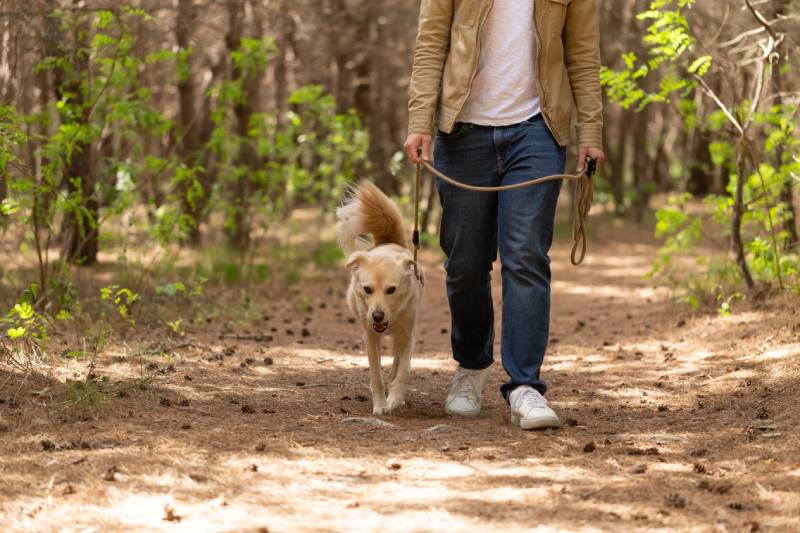
Training
These beautiful dogs, known for their intelligence and independence, can present both advantages and challenges when it comes to training. While they’re very smart and quick learners, their independent nature can sometimes make them a bit stubborn and less inclined to follow commands–like the Shiba. However, with the right approach and consistency, Korean Jindo dogs can be successfully trained.
One of the key factors in training a Korean Jindo dog is really establishing a strong bond and trust with them. These dogs are known to be loyal and devoted to their owners, so building a positive relationship based on trust is crucial. Daily consistency and positive reinforcement techniques, such as rewards and praise, work particularly well with Korean Jindo dogs.
They respond well to positive reinforcement and are motivated by treats and praise. Training sessions should be regular and focused, using clear and concise commands. Repetition is key, as it helps reinforce the desired behaviors and helps these dogs understand what is expected of them.
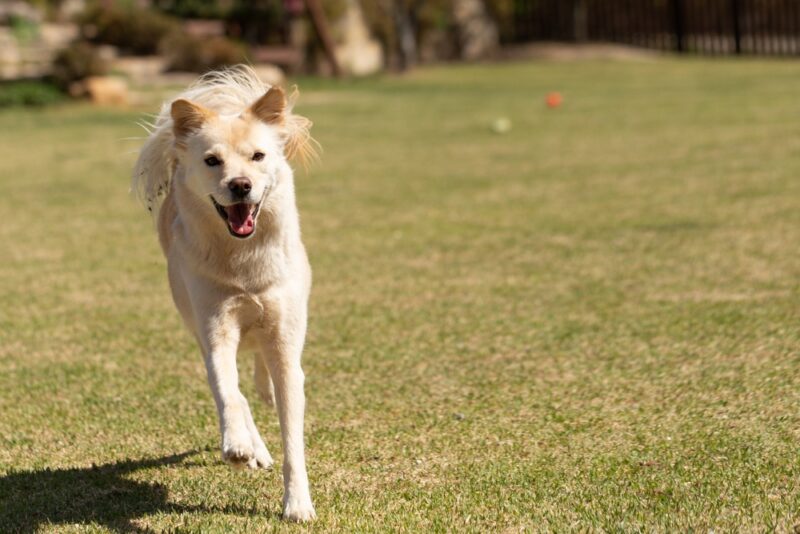
Health
One common health issue that affects Korean Jindos is hip dysplasia. This condition occurs when the hip joint is improperly formed, leading to discomfort and difficulty in movement. While it is a genetic condition, it can also be exacerbated by factors such as obesity and excessive exercise. Regular exercise and maintaining a healthy weight can help minimize the risk of hip dysplasia in Jindos.
Another health issue that Korean Jindos may face is allergies. These dogs can be sensitive to certain allergens, including pollen, dust mites, and certain foods. Allergies in dogs often manifest as skin irritations, itchiness, and excessive scratching. In severe cases, allergies can lead to secondary infections. Identifying and avoiding the allergens that trigger these reactions is important for managing allergies in Jindos. Additionally, regular grooming and maintaining a clean-living environment can help reduce exposure to potential allergens.
Eye problems are another health concern for Korean Jindo dogs. They are susceptible to conditions such as cataracts, corneal ulcers, and glaucoma. Regular eye examinations by a vet can help catch these issues early on and provide appropriate treatment. Additionally, maintaining good eye hygiene by regularly cleaning their eyes and ensuring they’re not exposed to irritants can help prevent eye problems.
Suitable For:
The Jindo is a strong-willed breed and requires consistent and positive reinforcement methods. They’re best with an owner who can dedicate enough time and attention to their Jindo, including meeting their exercise needs, as this breed thrives on companionship and can develop separation anxiety if left alone for long periods.

Which Breed Is Right for You?
When it comes to choosing a new furry companion, it’s essential to consider various factors to ensure that you find the breed that best suits your lifestyle and personality. Both breeds have their unique characteristics and traits that make them beloved by all types of dog owners. The Shiba Inu is smaller with an independent nature. They’re smart, alert, and make excellent watchdogs. However, they can be stubborn at times and require a firm, consistent hand in training. Shibas are generally not recommended for first-time dog owners or families with very young children.
On the other hand, the Korean Jindo is a bit bigger and known for their strong hunting instincts. They have a natural inclination towards guarding their family and property. Jindos are generally aloof with strangers but form strong bonds with their owners and their family. They require early socialization and firm training to prevent any aggressive tendencies. Jindos are best suited for experienced dog owners who can provide them with consistent leadership and plenty of mental and physical stimulation. So, ultimately, it depends on your own personal preference and lifestyle.
Related Reads:
- Jindo vs Akita: Differences Explained (With Pictures)
- Shikoku Dog vs. Shiba Inu: Differences Explained (With Pictures)
Featured Image Credit: (T) OlesyaNickolaeva, Shutterstock | (B) designer.oki, Shutterstock

